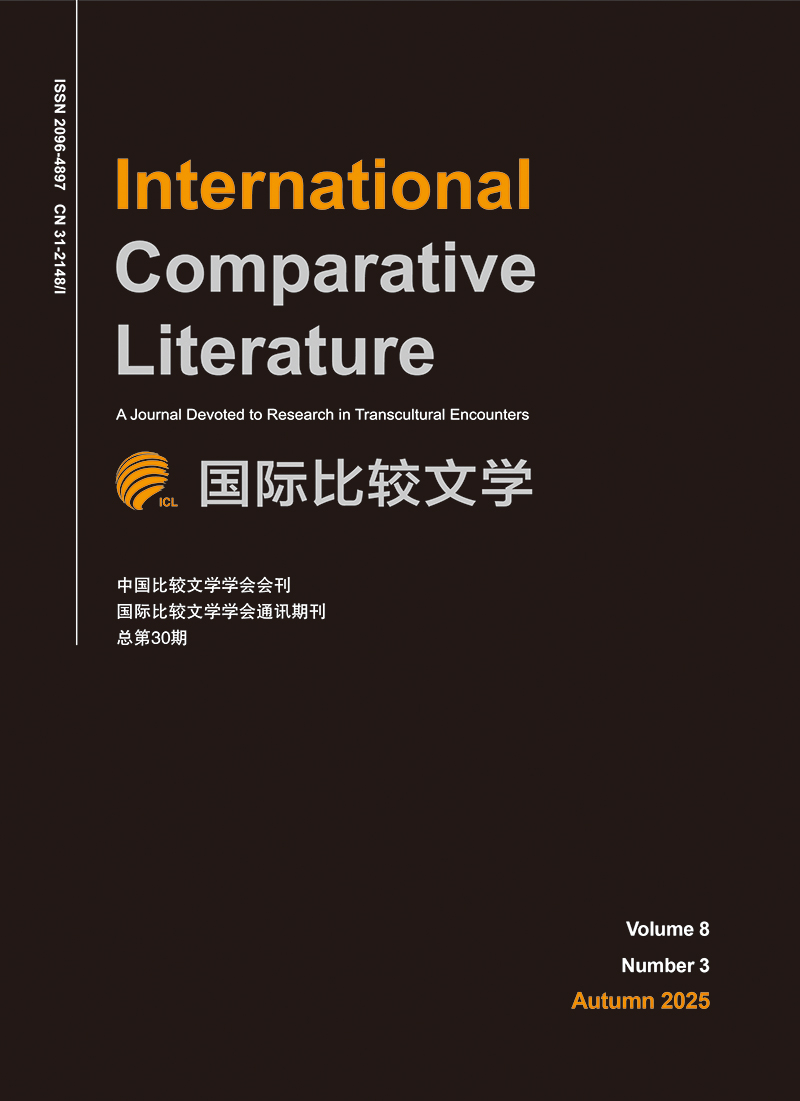|
[1]
|
艾尔曼:《早期现代还是晚期帝国的考据学?——18世纪中国经学的危机》,《复旦学报(社会科学版)》2011年第4期,第9-19页。
|
|
[2]
|
[Elman, Benjamin. "Early Modern or Late Imperial Philology?:The Crisis of Classical Learning in Eighteenth Century China." Fudan Journal (Social Sciences Edition), no. 4(2011):9-19.]
|
|
[3]
|
Barthes, Roland. "Éléments de sémiologie." Communications 4, no. 1(1964):91-135.
|
|
[4]
|
池田秀三:《训诂的虚与实》,石立善译,见彭林主编:《中国经学》第5辑,桂林:广西师范大学出版社,2009年,第1-24页。
|
|
[5]
|
[Ikeda Shūzō. "Virtuality and Actuality of Exegesis." Translated by SHI Lishan. In Chinese Confucianism, vol. 5. Edited by PENG Lin. Guilin:Guangxi Normal University Press, 2009, 1-24.]
|
|
[6]
|
(清)戴震:《孟子字义疏证·序》,见《戴震全书》第6册,合肥:黄山书社,1995年,第147-148页。
|
|
[7]
|
[DAI Zhen. "Mengzi ziyi shu zheng xu." In Complete Works of DAI Zhen, vol. 6. Hefei:Huangshan Publishing House, 1995, 147-8.]
|
|
[8]
|
(清)戴震:《与是仲明论学书》,见《戴震全书》第6册,合肥:黄山书社,1995年,第370-372页。
|
|
[9]
|
[DAI Zhen. "Yu SHI Zhongming lun xue shu." In Complete Works of DAI Zhen, vol. 6. Hefei:Huangshan Publishing House, 1995, 370-2.]
|
|
[10]
|
邓秉元:《什么是理想的新经学》,《文汇报》,2017年3月17日,第10版。
|
|
[11]
|
[DENG Bingyuan. "What Is the Ideal New Confucianism." Wen Hui Bao. March 17, 2017, 10.]
|
|
[12]
|
Gadamer, Hans-Georg. "Rhetorik und Hermeneutik." In Hans-Georg Gadamer Gesammelte Werke, Bd. 2, Hermeneutik Ⅱ:Wahrheit und Methode, Ergänzungen, Register, Tübingen:J. C. B. Mohr (Paul Siebeck), 1993, 276-91.
|
|
[13]
|
(清)龚自珍:《六经正名》,见《龚自珍全集》,上海人民出版社,1975年,第36-38页。
|
|
[14]
|
[GONG Zizhen. "Liu jing zheng ming." In Complete Works of GONG Zizhen, Shanghai:Shanghai People's Publishing House, 1975, 36-8.]
|
|
[15]
|
顾颉刚:《古史辨·自序》,见顾颉刚编著:《古史辨》第5册,上海古籍出版社,1982年,第1-20页。
|
|
[16]
|
[GU Jiegang. "Preface of Discussions in Ancient Chinese History." In Discussions in Ancient Chinese History, vol. 5. Edited by GU Jiegang, Shanghai:Shanghai Chinese Classics Publishing House, 1982, 1-20.]
|
|
[17]
|
顾颉刚:《跋钱穆评〈五德终始说下的政治和历史〉》,见顾颉刚编著:《古史辨》第5册,上海古籍出版社,1982年,第631-636页。
|
|
[18]
|
[GU Jiegang. "Postscript of QIAN Mu's Review of ‘Politics and History in the Doctrine of Circle of Five Virtues’." In Discussions in Ancient Chinese History, vol. 5. Edited by GU Jiegang, Shanghai:Shanghai Chinese Classics Publishing House, 1982, 631-6.]
|
|
[19]
|
顾颉刚:《崔东壁遗书序一》,见《顾颉刚全集》第7册,北京:中华书局,2010年,第51-177页。
|
|
[20]
|
[GU Jiegang. "Preface of CUI Dongbi's Corpus 1." In Complete Works of GU Jiegang, vol. 7. Beijing:Zhonghua Book Company, 2010, 51-177.]
|
|
[21]
|
(汉)何休注、(唐)徐彦疏:《春秋公羊传注疏》,见(清)阮元校刻:《十三经注疏》下册,北京:中华书局,1980年。
|
|
[22]
|
[HE Xiu and XU Yan. Chun qiu Gongyang zhuan zhu shu. In Shisan jing zhushu, vol. 2. Edited by RUAN Yuan. Beijing:Zhonghua Book Company, 1980.]
|
|
[23]
|
Heidegger, Martin. Sein und Zeit. In Martin Heidegger Gesamtausgabe, Bd. 2. Frankfurt am Main:Vittorio Klostermann, 1977.
|
|
[24]
|
——. Phänomenologische Interpretation von Kants Kritik der reinen Vernunft. In Martin Heidegger Gesamtausgabe, Bd. 25. Frankfurt am Main:Vittorio Klostermann, 1977.
|
|
[25]
|
Hjelmslev, Louis. Prolegomena to a Theory of Language. Translated by Frαncis J. Whitfield. Madison:The University of Wisconsin Press, 1969.
|
|
[26]
|
胡适:《中国古代哲学史》,见《胡适全集》第5卷,合肥:安徽教育出版社,2003年。
|
|
[27]
|
[HU Shi. History of Ancient Chinese Philosophy. In Complete Works of HU Shi, vol. 5. Hefei:Anhui Education Press, 2003.]
|
|
[28]
|
胡适:《考证学方法之来历》,见《胡适全集》第13卷,合肥:安徽教育出版社,2003年,第129-136页。
|
|
[29]
|
[HU Shi. "The Origin of the Method of Textual Criticism." In Complete Works of HU Shi, vol. 13. Hefei:Anhui Education Press, 2003, 129-36.]
|
|
[30]
|
胡适:《章实斋先生年谱》,见《胡适全集》第19卷,合肥:安徽教育出版社,2003年。
|
|
[31]
|
[HU Shi. Chronological Biography of ZHANG Shizhai. In Complete Works of HU Shi, vol. 19. Hefei:Anhui Education Press, 2003.]
|
|
[32]
|
Jansons, Linards. "What is the Second Naiveté?" Lecture, Australian Lutheran College, North Adelaide, SA, October 30, 2014.
|
|
[33]
|
梁启超:《清代学术概论》,见《饮冰室合集·专集》第9册,上海:中华书局,1936年。
|
|
[34]
|
[LIANG Qichao. Intellectual Trends in the Qing Period. In Yin Bing Shi Collections:Special Collection, vol. 9. Shanghai:Zhonghua Book Company, 1936.]
|
|
[35]
|
梁启超:《中国近三百年学术史》,见《饮冰室合集·专集》第17册,上海:中华书局,1936年。
|
|
[36]
|
[LIANG Qichao. Academic History of China in Recent Three Hundred Years. In Yin Bing Shi Collections:Special Collection, vol. 17. Shanghai:Zhonghua Book Company, 1936.]
|
|
[37]
|
(清)凌廷堪:《汪容甫墓志铭》,见《校礼堂文集》第卅五卷,清嘉庆十八年张其锦刻本,第12页a-13页b。
|
|
[38]
|
[LING Tingkan. "WANG Rongfu muzhi ming." In Jiao li tang wenji, vol. 35. Qing Jiaqing shiba nian ZHANG Qijin keben, 1813, 12a-13b.]
|
|
[39]
|
(清)卢文弨:《湖南科试诸生策问九首》,见《抱经堂文集》六·卷廿三,见《四部丛刊初编·集部》,上海:商务印书馆,1919年,第5页b-10页a。
|
|
[40]
|
[LU Wenchao. "Hunan keshi zhusheng cewen jiu shou." In Bao jing tang wenji, pt. 6, vol. 23. In Sibu congkan chubian:Ji bu. Shanghai:The Commercial Press, 1919, 5b-10a.]
|
|
[41]
|
(汉)毛公传,(汉)郑玄笺,(唐)孔颖达等正义:《毛诗正义》,见(清)阮元校刻:《十三经注疏》上册,北京:中华书局,1980年。
|
|
[42]
|
[MAO Gong, ZHENG Xuan and KONG Yingda. Mao shi Zhengyi. In Shisan jing zhushu, vol. 1. Edited by RUAN Yuan. Beijing:Zhonghua Book Company, 1980.]
|
|
[43]
|
Martin, Bronwen and Felizitas Ringham, Dictionary of Semiotics. London:Cassell, 2000.
|
|
[44]
|
(清)皮锡瑞:《经学通论》,北京:中华书局,2008年。
|
|
[45]
|
[PI Xirui. Jingxue tonglun. Beijing:Zhonghua Book Company, 2008.]
|
|
[46]
|
(清)钱大昕:《廿二史札记序》,见(清)赵翼:《廿二史札记》卷一,清嘉庆五年阳湖赵氏湛贻堂刻本,1800年,第1页a-2页b。
|
|
[47]
|
[QIAN Daxin. "Nian er shi zhaji xu." In ZHAO Yi. Nian er shi zhaji, vol. 1. Qing Jiaqing wunian Yanghu Zhaosi zhan yi tang keben, 1800, 1a-2b.]
|
|
[48]
|
钱玄同:《论〈诗〉说及群经辨伪书》,见顾颉刚编著:《古史辨》第1册,上海古籍出版社,1982年,第50-
|
|
[49]
|
52页。
|
|
[50]
|
[QIAN Xuantong. "On the Interpretation of Poetry and the Textual Criticism of Confucian Canons." In Discussions in Ancient Chinese History, vol. 1. Edited by GU Jiegang. Shanghai:Shanghai Chinese Classics Publishing House, 1982, 50-2.]
|
|
[51]
|
钱玄同:《重论经今古文学问题》,见顾颉刚编著:《古史辨》第5册,上海古籍出版社,1982年,第22-101页。
|
|
[52]
|
[QIAN Xuantong. "Reexamination on the Problem of the New Text School and the Old Text School." In Discussions in Ancient Chinese History, vol. 5. Edited by GU Jiegang. Shanghai:Shanghai Chinese Classics Publishing House, 1982, 22-101.]
|
|
[53]
|
Ricœur, Paul. Finitude et culpabilité Ⅱ:La Symbolique du mal. Paris:Éditions Montaigne, 1960.
|
|
[54]
|
——. "Philosophical Hermeneutics and Theological Hermeneutics." Studies in Religion/Sciences Religieuses 5, no. 1(Summer 1975):14-33.
|
|
[55]
|
施耐德:《真理与历史:傅斯年、陈寅恪的史学思想与民族认同》,关山、李貌华译,北京:社会科学文献出版社,
|
|
[56]
|
2008年。
|
|
[57]
|
[Schneider, Axel. Wahrheit und Geschichte:Zwei chinesische Historiker auf der Suche nach einer modernen Identität für China. Translated by GUAN Shan and LI Maohua. Beijing:Social Science Academic Press, 2008.]
|
|
[58]
|
徐宗泽编著:《明清间耶稣会士译著提要》,上海:中华书局,1949年。
|
|
[59]
|
[XU Zongze. Synopsis of Jesuits' Translations in the Ming and Qing Dynasties. Shanghai:Zhonghua Book Company, 1949.]
|
|
[60]
|
(汉)许慎:《说文解字》,北京:中华书局,1978年。
|
|
[61]
|
[XU Shen. Shuo wen jie zi. Beijing:Zhonghua Book Company, 1978.]
|
|
[62]
|
(汉)许慎撰,(清)段玉裁注:《说文解字注》,上海古籍出版社,1981年。
|
|
[63]
|
[XU Shen and DUAN Yucai. Shuo wen jie zi zhu. Shanghai:Shanghai Chinese Classics Publishing House, 1981.]
|
|
[64]
|
(清)王鸣盛:《十七史商榷序》,见《十七史商榷》,清光绪十九年《广雅丛书》本,1893年,第1页a-3页b。
|
|
[65]
|
[WANG Mingsheng. "Shiqi shi shangque xu." In Shiqi shi shangque. Qing Guangxu shijiu nian Guang ya congshu ben, 1893, 1a-3b.]
|
|
[66]
|
(清)王念孙:《说文解字注·序》,见(汉)许慎撰,(清)段玉裁注,《说文解字注》,上海古籍出版社,1981年,第1页。
|
|
[67]
|
[WANG Niansun. "Shuo wen jie zi zhu xu." In XU Shen and DUAN Yucai. Shuo wen jie zi zhu. Shanghai:Shanghai Chinese Classics Publishing House, 1981, 1.]
|
|
[68]
|
王宁:《训诂学原理》,北京:中国国际广播出版社,1996年。
|
|
[69]
|
[WANG Ning. Principles of Exegesis. Beijing:China International Broadcasting Press, 1996.]
|
|
[70]
|
(清)王引之:《经义述闻》,清道光七年寿藤书屋重刊本,1827年。
|
|
[71]
|
[WANG Yinzhi. Jing yi shu wen. Qing Daoguang qi nian shou teng shuwu chong kanben, 1827.]
|
|
[72]
|
杨乃乔:《口传注经与诠释历史的真值性(上)——兼论公羊学的诠释学传统和体例及其他》,《学术月刊》2016年第9期,第110-124页。
|
|
[73]
|
[YANG Naiqiao. "Oral Exegesis and the True Value of Interpreting History (Part I):With Notes on the Hermeneutic Tradition and Format of Gongyang School and Other Issues." Academic Monthly, no. 9(2016):110-24.]
|
|
[74]
|
余英时:《戴震与章学诚:清代中期学术思想史研究》,北京:三联书店,2000年。
|
|
[75]
|
[YU Yingshi. DAI Zhen and ZHANG Xuecheng:A Study of the History of Academic Thought in the Middle Qing Dynasty. Beijing:SDX Joint Publishing Company, 2000.]
|
|
[76]
|
(清)章学诚:《文史通义》,民国十一年吴兴刘氏嘉业堂刊《章氏遗书》本,1922年。
|
|
[77]
|
[ZHANG Xuecheng. Wen shi tong yi. Minguo shiyi nian Liushi jia ye tang kan Zhangshi yishu, 1922.]
|
|
[78]
|
张荫麟:《评近人对于中国古史之讨论》,《学衡》1925年第40期,第1-18页。
|
|
[79]
|
[ZHANG Yinlin. "Review of Contemporary Essays on Ancient Chinese History." The Critical Review, no. 40(1925):1-18.]
|
|
[80]
|
赵敦华:《从古典学到解释学的西学传统的启示》,《光明日报·理论周刊》,2009年6月30日,第11版。
|
|
[81]
|
[ZHAO Dunhua. "An Inspiration of Western Learning Tradition from Classical Studies to Hermeneutics." Theory Weekly, Guangming Daily. June 30, 2009, 11.]
|
|
[82]
|
周予同:《怎样研究经学》,见《周予同经学史论著选集》增订本,上海人民出版社,1996年,第627-635页。
|
|
[83]
|
[ZHOU Yutong. "How to Study Confucianism." In Anthology of Zhou Yutong's Study of History of Confucianism. Revised and enlarged ed. Shanghai:Shanghai People's Publishing House, 1996, 627-35.]
|
|
[84]
|
周予同:《经学历史·序言》,见(清)皮锡瑞著,周予同注:《经学历史》,北京:中华书局,2008年,第1-16页。
|
|
[85]
|
[ZHOU Yutong. "Preface to A History to Confucianism." In PI Xirui and ZHOU Yutong. A History of Confucianism. Beijing:Zhonghua Book Company, 2008, 1-16.]
|
|
[86]
|
朱维铮:《十八世纪的汉学与西学》,见《走出中世纪》增订本,上海:复旦大学出版社,2007年,第136-162页。
|
|
[87]
|
[ZHU Weizheng. "Han Studies and Western Learning in the 18th Century." In Out of the Middle Ages. Revised and enlarged ed. Shanghai:Fudan University Press, 2007, 136-62.]
|

 点击查看大图
点击查看大图



 下载:
下载:

